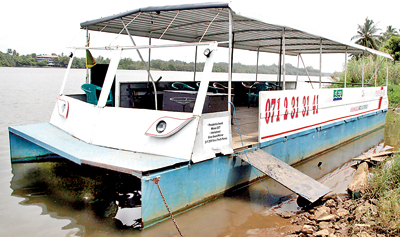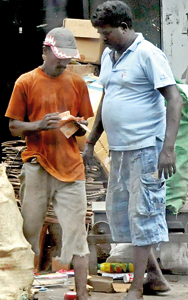On course on his eco-friendly boat
In 1915, I.S. Waidiyarathna Karunatilake’s grandfather obtained a licence for passenger and cargo transportation in waterways, from the British administration at that time. However, when Karunatilake decided to follow in his grandfather’s footsteps he faced an obstacle – the prohibition of motorboats by the National Environmental Act due to pollution caused by their operation.
Undaunted, Karunatilake, an accountant by profession, arrived at an ingenious solution. He set about designing and building his own eco-friendly boat!

A boat like no other: Karunatileke’s innovative design. Pix by M.A. Pushpa Kumara
“I initially wanted to build a flying boat, but came up with this boat in the process,” explains Karunatilake, one of the nominees for The Ray award.The invention earned well deserved recognition for Karunatilake, who won the Presidential award in 2007 for the design. In addition, Karunatilake also brought fame to Sri Lanka, when he won the International Silver Prize for his designs, at the Seoul International Invention Fair (SIIF) 2009.
What is it that makes this boat unique and environment-friendly?
Unlike the usual motorboats made of fibreglass, this boat is made of steel and aluminum which can be recycled. Fibreglass on the other hand, cannot be recycled nor destroyed, as destroying it would cause much pollution to the environment.
At this point the question as to the durability of a boat made of steel and aluminum naturally arises. However, Karunatilake has thought about that too. “I have used anodic protection which reduces corrosion and makes the boat durable,” he says, adding that the boat can transport up to 50 passengers or cargo weighing 4000kg.
Evidently, much thought has gone into it as Karunatilake’s invention ensures that energy is not wasted but is instead used efficiently.
“River bank erosion and destruction of the life-cycle of creatures living in the river occur when waves are generated,” says Karunatilake going on to say that energy too is wasted as the waves carry the energy to the river banks.
Karunatilake has found a solution to this problem by changing the shape of the hull so that it is not symmetric as in other boats. Thus, waves are not generated when the boat travels through the water resulting in not only a smooth ride, but preservation of the environment too.

The boat builder Karunatilake
“In addition, the wave energy is re-used as the propeller runs on the energy contained in those waves” adds Karunatilake. Fuel consumption is less in this case as energy is not wasted in wave generation.
Surely, by now, there are enough advantages packed into one boat? Not quite! The inventor explains that there are no airspaces as found in other boats. “The entire boat is filled with foam and thus water cannot fill the boat.”
Karunatilake hopes that this invention will prove to be not only an alternate mode of transport, but also an asset to the tourist industry as well as playing an important role in rescue operations in disaster management such as flooding of rivers.
The boat which was completed in November 2011 and launched the following month, makes several trips up and down the Kalu Ganga every day, giving passengers a relaxing and eco-friendly option of transportation as opposed to the noise and pollution on the busy city roads.
Follow @timesonlinelk
comments powered by Disqus
























